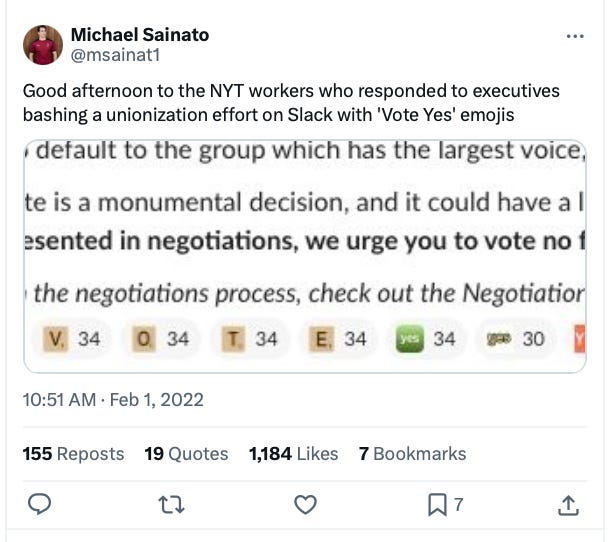The New York Times Has A Slack Emoji Problem
Read to the end for a story about Mother Jones race relations on Slack.
Dall-E’s response to the prompt: “a wide image of two emojis eating one another”
Like every other newsroom in the world, The New York Times uses Slack. Every newsroom has Slack drama. But the New York Times seems to have emoji-specific Slack drama.
Every story about internal drama at the New York Times always mentions Slack emoji. The latest example is in the Atlantic, where Adam Rubenstein has published an essay called “I was a Heretic at The New York Times.”
Rubenstein was the primary editor for the Tom Cotton op-ed in 2020 about “sending in the troops,” which ultimately led to James Bennet’s forced resignation.
Rubenstein writes:
Cotton’s office had emailed me several photos that they wanted to see published alongside the op-ed, showing times when the same legal doctrine had been invoked in the past. One was of U.S. troops enforcing the desegregation of the University of Mississippi in 1962. I sent these to a photo editor, Jeffrey Henson Scales, and asked him to “consider” them. He wrote me back to say, “A false equivalence, but historical images are there now,” meaning he’d added them to the story file in the system. I thanked him and added a “confusion” emoji, in case he wanted to expand on what he meant. He replied by sending me the emoji of a black box, representing solidarity with the Black Lives Matter movement.
This interaction then gets misreported by the paper:
Later that day, the Times published a story by Lee and two other reporters. “The Op-Ed was edited by Adam Rubenstein,” the article said. It devoted five paragraphs to my interaction with the photo editor, who had, against company policy, shared with the reporters some of our Slack messages.
Mr. Scales raised an objection. “A false equivalence, but historical images are there now,” he wrote to Mr. Rubenstein on Slack, the internal messaging software used by Times employees.
“Yeah, there are a few in there,” Mr. Rubenstein responded.
The full exchange made clear that I had been talking about the photos; presented this way, many read it as a confession that I believed the article was drawing false equivalences. Indeed, after this account came out, The Washington Post described me as having “shrugged off accuracy issues.”
Everyone is focusing on other parts of this essay but I want to zag and provide you with a brief history of NYT Slack emoji drama. It is one of my favorite recurring motifs.
The first time I noticed it was in 2020, in the aftermath of this op-ed.
Ben Smith, who was then the NYT media reporter, wrote a piece about all of the drama:
When The New York Times forced out the opinion editor James Bennet over a controversial column a week ago, two employees reacted in Slack with a slackmoji of the word “guillotine,” prompting internal complaints, a Times reporter said. “We encourage constructive, honest dialogue among our colleagues but there are lines that can be crossed, and this was one of them,” Times spokeswoman Eileen Murphy said in response.
Then when Bari Weiss resigned, she wrote about being bullied with Slack emoji:
My work and my character are openly demeaned on company-wide Slack channels where masthead editors regularly weigh in. There, some coworkers insist I need to be rooted out if this company is to be a truly “inclusive” one, while others post ax emojis next to my name. Still other New York Times employees publicly smear me as a liar and a bigot on Twitter with no fear that harassing me will be met with appropriate action. They never are.
When the Wirecutter wanted to unionize, Choire Sicha wrote in New York Mag about the slack emojis:
Management is not happy. In the Times all-company Slack, David Perpich, whose title is head of standalone products, which means he oversees things like Wirecutter and the Cooking product — and whose grandfather is Arthur Ochs Sulzberger — posted a message saying that, while the institution understood the right to strike, management was “disappointed.” He wrote:
“Strikes are extreme measures that are typically reserved for instances in which an employer is not willing to negotiate further. With the Wirecutter Union, we are very close to reaching an agreement and have remained willing to engage in the necessary give and take of negotiations to try to reach overall agreement.”
Emoji reactions to his Slack post, as of about 11 a.m. on Wednesday, were not friendly. They included union logos and at least 39 people posting a fist raised in solidarity, 34 people posting a grimace, 38 people posting the thinking-face emoji, plus 12 people responding with an emoji depicting Gritty, the chaos-oriented Philadelphia Flyers mascot.
When the NYT union was involved in labor drama in 2022, the substacker Eliz Mizon wrote a post titled “NYT Tech Staff Use 'Slack Hack' to Fight Union Busting.” What was the hack? Emojis.
But not just any old slack emojis. These were special Slack emojis.
Over and above using available reacts to spell “vote yes”, Tech Guild members also uploaded bespoke reacts, such as the Guild logo, and perhaps their most inspired move: a number of bright red, re-labelled, ‘info’ squares.
When staff hover their pointer over (or ‘mouseover’, thanks Tim) those info reacts, each one is titled with rebuttals such as :unions-dont-make-things-harder-they-ensure-we-are-heard:.
Maybe the NYT should deactivate Slack emojis?
I was involved in lots of Slack drama at Mother Jones but I can think of only one time when the emojis played a role, and it was a secondary role.
Storytime: Mother Jones/Slack/Race/N-Word/Drama
Keep reading with a 7-day free trial
Subscribe to Calm Down to keep reading this post and get 7 days of free access to the full post archives.





